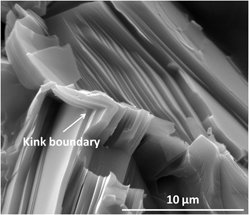Article contents
In situ synthesis of paper-derived Ti3SiC2
Published online by Cambridge University Press: 02 May 2017
Abstract

A novel approach based on the preceramic paper method was used for the fabrication of Ti3SiC2-based material. Elemental powders of Ti, TiC, Si, C, and organic additives were used as starting materials. The Rapid Köthen process was used to fabricate the preceramic papers. The high-loaded green body of preceramic papers was heat-treated up to varying temperatures of 1300, 1400, 1500, and 1600 °C for 1 h in an Ar atmosphere. By using an excess amount of Si powder in the basic composition, the amount of Ti3SiC2 in the sintered specimen could be increased while the amount of TiC could be reduced. X-ray analysis showed that the paper-derived sample with the basic powder composition 3Ti/3TiC/3Si/C was a single phase within the resolution limit of the instrument used. The high purity of Ti3SiC2 can be explained by the partial formation of amorphous C which could not be detected by X-ray diffraction. Scanning electron microscopy analysis of fracture surfaces showed the characteristic lamellar structure of the paper-derived MAX phase.
Keywords
- Type
- Invited Articles
- Information
- Journal of Materials Research , Volume 32 , Issue 17: Focus Issue: Achieving Superior Ceramics and Coating Properties through Innovative Processing , 14 September 2017 , pp. 3409 - 3414
- Copyright
- Copyright © Materials Research Society 2017
Footnotes
This author was an editor of this journal during the review and decision stage. For the JMR policy on review and publication of manuscripts authored by editors, please refer to http://www.mrs.org/editor-manuscripts/.
Contributing Editor: Xiaowei Yin
References
REFERENCES
- 9
- Cited by



